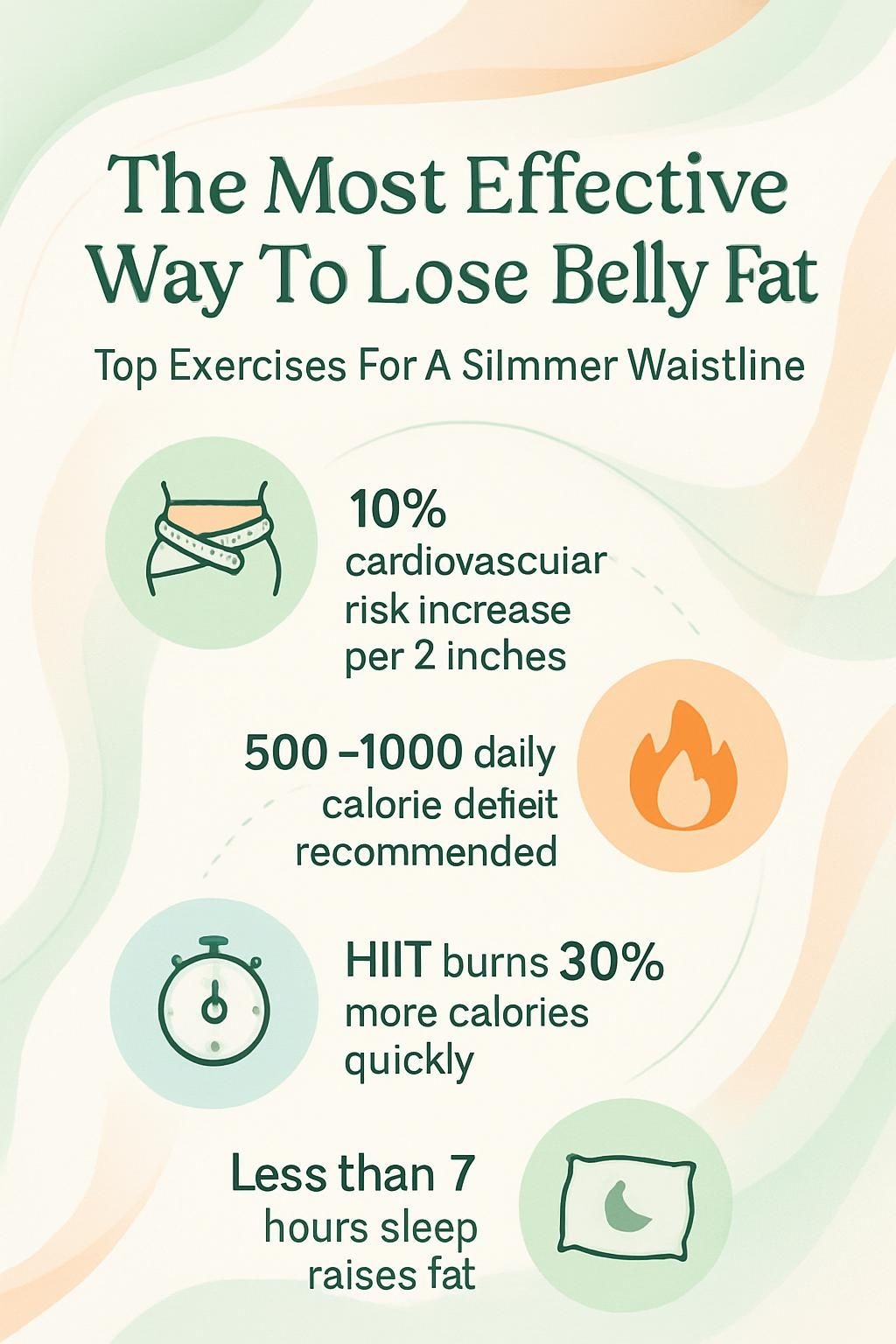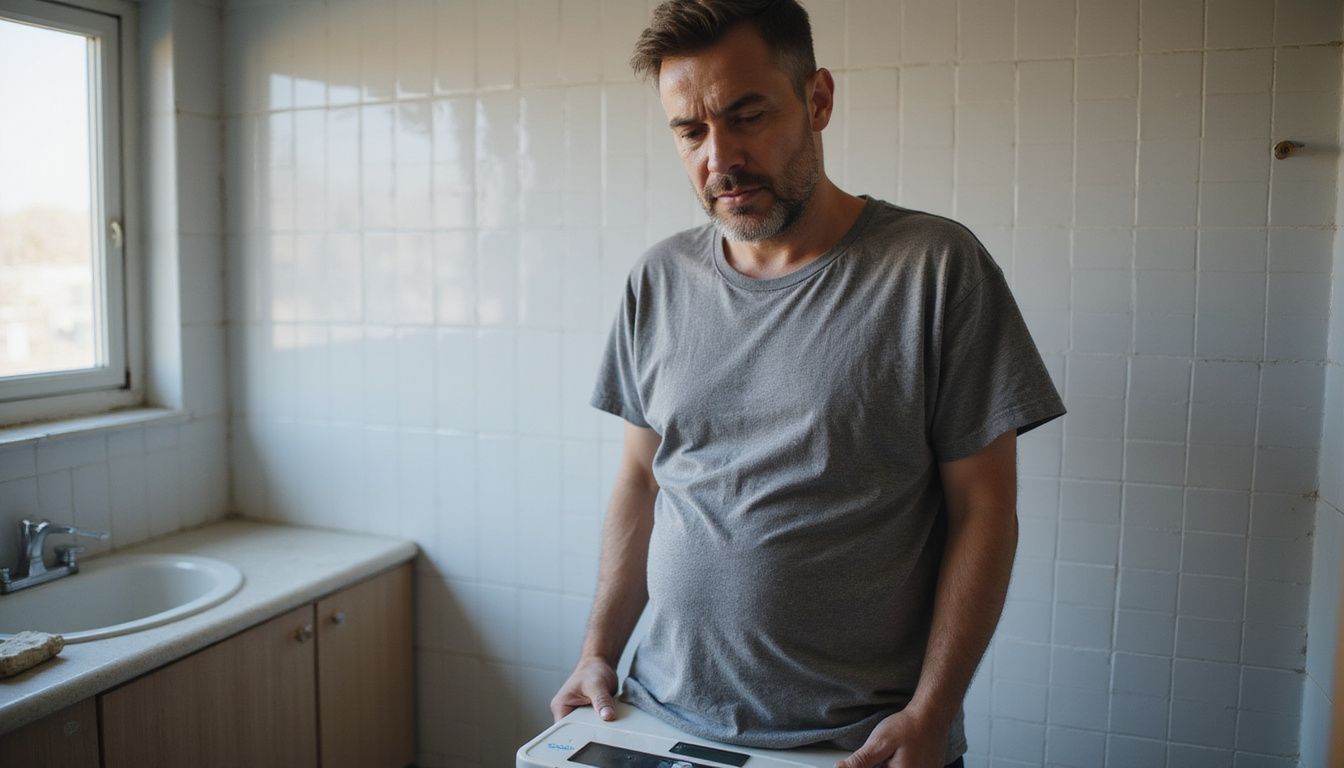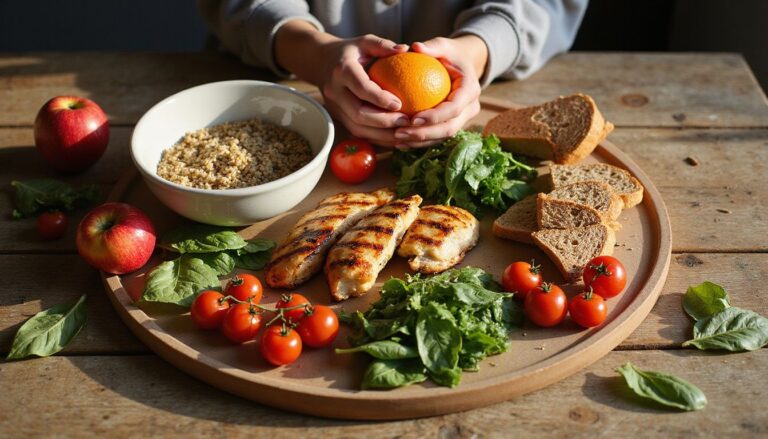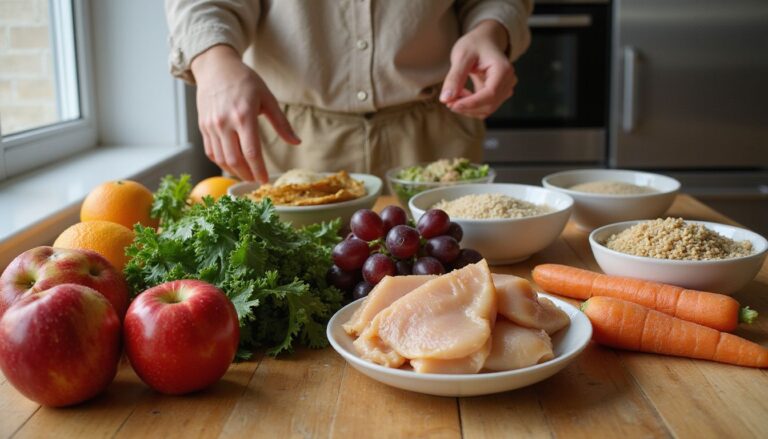The Most Effective Way To Lose Belly Fat: Top Exercises For A Slimmer Waistline
Our Nutrition Assistant AI Suite will transform your body. You will lose fat, get toned, and build muscle. Gain confidence and optimal health.
Struggling with stubborn belly fat can feel discouraging. The good news is that science-backed habits make a real difference. In this guide, you will learn practical ways to lose belly fat with smart training, a supportive diet, and simple daily routines.
Extra fat around your waistline raises the risk of heart disease, type 2 diabetes, and some cancers. You will see how to pair the best exercises to lose abdominal weight with nutrition steps that support a slimmer waistline. Start your plan today, keep reading for clear actions that work in real life.
Key Takeaways
- Visceral belly fat raises risks for heart disease, diabetes, and dementia. Each extra 2 inches on your waist links to about a 10% higher cardiovascular risk.
- A steady calorie deficit of 500 to 1000 calories per day, plus 150 minutes of aerobic exercise weekly and strength training, supports safe fat loss.
- More soluble fiber and lean proteins, along with fewer trans fats and added sugars, help reduce abdominal fat and improve metabolic health.
- High-intensity interval training may burn up to 30% more calories in 20 minutes than steady cardio. Strength training preserves muscle mass and keeps your metabolism higher during weight loss.
- Short sleep, chronic stress, smoking, and heavy alcohol intake all increase visceral fat, even if your body mass index looks normal.

Understanding Different Types of Belly Fat and Health Risks

Belly fat is not all the same, and the type matters for your health. Knowing the difference helps you focus on changes that protect your heart, blood sugar, and brain.
What Are Subcutaneous and Visceral Fat?
Subcutaneous fat sits right under the skin. It cushions the body and stores energy. This is the soft fat you can pinch on your belly, hips, or thighs.
Visceral fat lies deeper in the abdomen around the liver, pancreas, and intestines. It makes up a smaller share of total body fat, yet it raises health risks more than subcutaneous fat. Visceral adipose tissue releases hormones and inflammatory signals, called cytokines, that can raise inflammation and worsen insulin resistance.
Age, genes, menopause, and pregnancy can change how much visceral belly fat you store. Unlike fat near the skin, deeper fat can push the waist outward even if your weight stays stable. The upside, visceral fat often responds faster to diet and activity than fat in the hips or thighs.
How Does Belly Fat Affect Your Health?
Visceral fat raises blood pressure, blood sugar, and triglycerides. It can also lower HDL, the so-called good cholesterol. Research in women ages 45 to 79 shows larger waists more than doubled heart disease risk. Every 2-inch increase in waist size added roughly 10% more cardiovascular danger.
Higher visceral fat is also linked with a greater chance of precancerous colon polyps and higher levels of angiotensin, a protein that can raise blood pressure. In a large Kaiser Permanente study, adults with more belly fat in their 40s were almost three times more likely to develop dementia later in life.
Other findings point to higher asthma risk in women with waists above 35 inches and greater breast cancer risk in premenopausal women with the largest waist-to-height ratios. Reducing belly fat can cut these dangers and support long-term health.
Scientific Approaches to Losing Belly Fat
Two pillars drive steady fat loss, a calorie deficit and consistent exercise. Together, they deliver better waist reduction and help you keep the results.
What Is a Calorie Deficit and How Does It Work?
A calorie deficit means you eat fewer calories than your body uses each day. Your body then draws on stored fat, including belly fat, to fill the gap. A safe target is a 500 to 1000 calorie deficit per day, which usually leads to about 1 to 2 pounds lost per week.
Tracking food and activity with a journal or app improves awareness and accuracy. Logging meals helped me spot how snacks and sugary drinks slowed my progress and made change feel manageable.
“Weight loss starts with creating a calorie deficit through diet, exercise, or both.”
Owning your numbers supports steady weight management and helps reduce harmful visceral fat.
Why Is a Balanced Lifestyle Important for Fat Loss?
Cutting calories alone rarely lasts. A balanced plan combines aerobic exercise, strength training, and mostly whole foods. Health organizations such as the Mayo Clinic and the CDC encourage consistent, long-term habits instead of short crash diets.
Build meals around vegetables, fruits, lean proteins, beans, nuts, and fish. Spend time with people who value healthy choices because social cues shape your actions. Aim for at least 150 minutes of moderate activity each week. Small, steady steps work best and keep lost inches from returning.
Nutritional Adjustments for Belly Fat Reduction
Food choices can support a slimmer waistline and better metabolic health. The following strategies help manage hunger, lower total calories, and improve blood markers linked to risk.
How Can Increasing Soluble Fiber Help Reduce Belly Fat?
Soluble fiber absorbs water in the gut and forms a gel. This slows digestion, helps you feel full, and can reduce calorie intake. Studies suggest that adding 10 grams of soluble fiber per day may lower belly fat gain by about 3.7% over five years.
Choose oats, barley, beans, apples, and carrots to boost soluble fiber. I swapped pastries for oatmeal and added beans to lunch. Hunger dropped, and staying in a calorie deficit got easier.
Why Should You Cut Down on Trans Fats?
Trans fats form during the hydrogenation of oils. They promote inflammation and are linked to greater abdominal fat and heart disease. Packaged snacks, some baked goods, and certain stick margarines often contain partially hydrogenated oils.
Reducing trans fats may lower visceral fat and improve cholesterol. It can also reduce stress-related hormones that encourage fat storage around the waist.
What Are the Benefits of Adding Lean Proteins?
Lean proteins like chicken, fish, tofu, eggs, and Greek yogurt increase fullness hormones, preserve muscle mass, and may raise your metabolic rate slightly. More muscle means more calories burned at rest.
People who eat adequate protein tend to carry less abdominal fat. Build meals with beans, fish, and low-fat dairy to help manage appetite and support body composition goals.
How Does Reducing Sugars and Refined Carbs Affect Belly Fat?
Lowering added sugars and refined grains helps shrink belly fat. Excess sugar, especially fructose, is tied to higher visceral fat. Sweet drinks, juice, and processed snacks often hide more sugar than expected.
Replace white bread, pastries, and white rice with whole grains or starchy vegetables. Many people lose more abdominal fat on lower-carb plans, especially if they have overweight, type 2 diabetes, or PCOS. I switched from soda to water and from white rice to brown rice, and my waist dropped two inches in three months.
What Are the Hydration Benefits and Role of Green Tea?
Green tea hydrates without added sugar and provides caffeine plus EGCG, a plant compound that may support fat loss. Research shows that drinking green tea with total catechins under 500 mg per day for about 12 weeks can reduce body weight and shrink the waist.
Use unsweetened hot or iced green tea as a stand-in for soda or sweet teas. Plain water or sparkling water with lemon also helps control calories from drinks.
Effective Exercises for Trimming Belly Fat
Exercise helps you burn calories and protect muscle. Cardio and strength training work together like two oars, they move you forward faster.
What Are the Best Cardio Exercises for Belly Fat?
Aerobic exercise raises your heart rate and increases calorie burn. Build a weekly plan you can keep up long term.
- Brisk walking for 150 minutes per week helps reduce total body fat and improves fitness.
- Running raises calorie burn and can reduce deep abdominal fat. Even two moderate runs a week help.
- Swimming recruits many muscle groups. In one study, postmenopausal women lowered both subcutaneous and visceral fat with regular swimming.
- Cycling strengthens leg and core muscles and can speed up metabolism. Three sessions per week can shift body weight over time.
- High-intensity interval training, short hard bursts with recovery, boosts calorie burn during and after workouts.
- Rowing works the legs, back, arms, and core. Depending on effort, it can burn hundreds of calories per hour.
- Jump rope sessions provide quick, intense cardio. Ten minutes daily adds up to meaningful energy burn.
- Group dance classes like Zumba add fun and community, which keeps motivation high.
Mixing activities kept me engaged after college and trimmed my waist faster than any single workout.
How Does High-Intensity Interval Training (HIIT) Help Lose Belly Fat?
HIIT uses short, intense efforts followed by brief recovery. It saves time and raises calorie burn more than steady cardio in many cases. Studies suggest HIIT can reduce both surface fat and deeper visceral fat that harms health.
One trial found people burned up to 30% more calories in 20 minutes with HIIT compared with traditional cardio. The method is efficient, especially on busy days.
Why Include Strength and Resistance Workouts?
Strength training builds lean muscle mass. Muscle is active tissue, it burns calories even when you rest. That helps you lose fat without slowing your metabolism.
Research in teens showed that combining strength and aerobic training led to the largest drop in visceral fat. Resistance training may also help people with prediabetes, type 2 diabetes, or fatty liver disease reduce abdominal fat. If you are new to lifting, get guidance from a coach or your clinician.
How Do Core Strengthening Exercises Like Planks and Crunches Help?
Core exercises do not spot reduce belly fat. They do strengthen and shape the muscles under the fat, which improves posture and performance during cardio and lifting.
- Planks, sit-ups, and crunches target the abdominals, obliques, and lower back.
- Better posture can make your waist look slimmer and reduce back strain.
- More core strength can raise your exercise capacity, so you burn more calories.
- Core work supports safe movement in daily tasks and sports.
- Regular core training helps slow age-related muscle loss in the midsection.
- Strong trunk muscles may ease some types of back pain.
- Pair core workouts with balanced nutrition for visible results over time.
- Use a soft tape measure to track waist changes every few weeks.
Next, see how strength training boosts metabolism and reshapes body composition.
Advantages of Strength Training
Strength training helps protect muscle during weight loss, supports a higher metabolism, and improves the look of your waist. It is a key partner to cardio.
How Does Muscle Building Enhance Metabolism?
Muscle requires more energy to maintain than fat. Adding muscle raises resting energy expenditure, which means you burn more calories all day. Pairing a higher protein intake with resistance training supports muscle gain and protection during a calorie deficit.
Since muscle mass tends to decline with age, consistent strength work helps keep your metabolic rate steadier. Mayo Clinic guidance suggests people who lift regularly maintain better metabolic health and respond more effectively to nutrition changes.
How Can Strength Training Improve Body Composition?
Resistance training helps reduce unhealthy belly fat while preserving or building lean mass. This lowers body fat percentage and supports a smaller waist.
Studies show that teens with overweight or obesity who combined strength and aerobic exercise reduced visceral fat the most. Stronger muscles also protect joints and make everyday movement easier, which helps you stick to an active lifestyle.
Lifestyle Modifications for a Leaner Waist
Small daily habits add up like compound interest. The following changes lower stress on your body and help keep your waistline in check.
Why Is Adequate Sleep Crucial for Belly Fat Loss?
Sleeping fewer than 7 hours per night is linked with more visceral fat, especially in younger adults. In a 16-year study of more than 68,000 women, those who slept under 5 hours were more likely to gain weight than those who slept 7 hours.
Sleep loss raises cortisol, a stress hormone that promotes fat storage around the midsection. Poor sleep quality and sleep apnea can make weight control even harder. If you suspect a sleep disorder, speak with a healthcare professional to protect your long-term health.
What Are Effective Stress Management Techniques?
Stress can increase appetite and drive belly fat gain. Use simple tools daily to steady your nervous system and lower cortisol.
- Practice mindfulness for 10 minutes. Short sessions can calm racing thoughts.
- Do yoga to pair movement with breath and release muscle tension.
- Get at least 150 minutes of moderate exercise weekly to improve mood and blood flow.
- Limit caffeine if it worsens anxiety or poor sleep.
- Choose healthy fats such as olive oil, nuts, and avocado at meals.
- Keep alcohol intake low, since heavier use is linked to more belly fat.
- Set a regular sleep schedule to stabilize hormones and hunger.
- Lean on supportive friends or family who model healthy choices.
- Use slow belly breathing during tense moments, for example four seconds in, six seconds out.
- Write down three brief gratitudes daily to train attention toward positives.
During exam season last year, I took daily 20-minute walks and practiced slow breathing. Cravings dropped and my pants fit better, even with a heavy workload.
How Do Smoking and Excessive Drinking Impact Belly Fat?
Smoking is tied to more abdominal fat and higher health risks. Heavy drinking also promotes fat storage around the waist. One analysis linked alcohol intake to larger waist size. Another study found people who drank small amounts more often had less belly fat than those who drank larger amounts on fewer days.
Experts suggest up to two drinks per day for men and one for women. Cutting back helps your waist and supports better sleep and recovery.
Debunking Myths About Belly Fat Reduction
Myths can waste time and energy. Focus on proven methods that change total body fat, not quick tricks.
Is Spot Reduction Effective for Losing Belly Fat?
No, spot reduction does not work. Doing sit-ups makes ab muscles stronger, but it does not selectively burn the fat above them. Decades of research show fat loss happens across the body, not in only one chosen area.
Create a calorie deficit and move more to shrink total fat, including the deep fat around organs. Full-body cardio and strength training drive the change your waist needs.
What Is the Reality Behind Quick Fixes and Fad Diets?
Crash plans may drop weight fast, but most of that loss is water or muscle. The pounds often return once the plan ends. Studies from the National Institutes of Health show many people regain lost weight within one to five years after strict diets.
Choose steady habits you can live with, like more vegetables, lean protein, and fiber, and fewer sugary drinks. I saw better results swapping soda for water and cooking more at home than with any shortcut or cleanse.
Monitoring Your Fat Loss Progress
What you track improves. Use simple tools to see honest trends, then adjust your plan with confidence.
How Do You Measure Your Waistline Accurately?
Stand tall, relax your abdomen, and measure at the level of your navel. Wrap a soft tape around your waist, keep it snug but not tight, and ensure it stays level all the way around.
For many adults, 35 inches or more for women and 40 inches or more for men signals higher visceral fat and greater health risk. Clothing fit can also show changes between formal measurements. Although scans can measure visceral fat directly, tape and BMI remain useful, low-cost tools.
What Are the Best Ways to Track Workouts and Calories?
Consistent tracking keeps you in a calorie deficit and highlights what to adjust.
- Use a food diary or app to log calories and macronutrients.
- Read labels to spot hidden sugars and refined carbs in packaged foods.
- Wear a fitness tracker to capture steps, heart rate, and workouts.
- Record cardio, HIIT, strength, and core sessions with time and intensity.
- Weigh in weekly under similar conditions for a clear trend line.
- Measure your waist every two weeks at the navel for consistent data.
- Review logs monthly to identify plateaus, then adjust calories or training.
These steps align your daily actions with your goals and make progress easier to see.
Frequently Asked Questions on Belly Fat Loss
The questions below address how long change takes, which exercises help most, and whether diet changes are required.
How Long Does It Take to Lose Belly Fat?
Most people see early changes within several weeks of steady habits. A 1 to 2 pound weekly loss is common with a calorie deficit, regular exercise, and supportive nutrition.
Losing belly fat in only 7 days is not realistic. Body systems need time to adapt. Measure your waist every two weeks to track true progress without daily noise.
What Exercises Are Most Effective for Belly Fat?
Brisk walking, cycling, swimming, and similar aerobic exercise help burn calories and trim your waistline. Aim for at least 150 minutes each week at a moderate intensity.
HIIT uses short, intense bursts with brief rests and is time-efficient. Strength training is essential, since muscle boosts your resting metabolism and protects against regain. Studies from 2014 show that teens who combine strength and aerobic exercise lose more visceral fat than those who do one type alone^1^. Core moves such as planks and crunches shape the midsection, but they work best when paired with full-body cardio and lifting.
…
1: Reference: “Combination of Strength & Aerobic Exercise Reduces Greater Visceral Fat in Teens,” Journal of Sports Sciences, 2014
Can You Lose Belly Fat Without Changing Your Diet?
Exercise helps, but relying on workouts alone makes fat loss harder. Research and expert reviews from 2012 and 2021 show a calorie deficit is needed to reduce fat around organs such as the liver and pancreas.[1] You cannot target fat in one spot, so your best option is to combine nutrition shifts with training.
When I walked daily and swapped sugary snacks for nuts and lean protein, my results improved quickly. Pair diet and exercise for consistent loss of abdominal and visceral fat.
Maintaining Motivation and Consistency
Clear goals and regular check-ins keep you on track. Support from others can carry you through low-motivation days.
How Do You Set Achievable Fat Loss Goals?
Pick small, specific goals you can hit each week. Focus on losing 1 to 2 pounds weekly and measure your waist at the navel to track inches. Clothing fit can serve as an added checkpoint between measurements.
Celebrate non-scale wins, like easier workouts or a belt that moves to a new hole. These small signals confirm your plan is working.
Why Is Building a Support Network Important?
People around you shape your habits. Spend time with those who enjoy healthy meals and regular activity. Their routines make your plan easier to follow.
Sharing goals raises accountability and boosts morale. Working out with a group helped me push through plateaus I would have skipped alone. Steady encouragement increases long-term success.
Conclusion
A slimmer waistline comes from steady habits, smart nutrition, and consistent exercise. Use cardio to burn calories, strength training to protect muscle, and core work to build a solid base. These steps help reduce belly fat and support better health.
Small changes, like more fiber and protein and fewer sugary drinks, add up across weeks and months. Track your progress, adjust as needed, and be patient. This article is for education, not a medical diagnosis. If you have a condition or take medication, consult a healthcare professional before changing your diet or exercise plan.
FAQs
1. What are the most effective exercises for reducing body fat around the waistline?
Research shows that aerobic activities such as brisk walking, cycling, and swimming help lower overall body fat, including in the waistline area. Strength training also supports muscle growth and increases metabolism, which can further reduce abdominal fat.
2. How does nutrition affect belly fat loss compared to exercise alone?
Studies indicate that a balanced diet rich in whole foods like vegetables, lean proteins, and nuts (fruit) plays a key role in losing belly fat. While exercise burns calories and builds muscle mass, proper nutrition helps control calorie intake and supports healthy organ function.
3. Can spot reduction target only the waistline or specific organs under belly fat?
Scientific evidence suggests spot reduction is not possible; targeted exercises do not remove fat from one area alone. Fat loss occurs throughout the body based on genetics and overall activity levels rather than focusing on specific organs or clothing areas like the waistline.
4. Are there any personal experiences showing how combining diet with top exercises impacts results?
After following an evidence-based plan of regular aerobic workouts combined with strength training and eating more nuts (fruit), I noticed my clothes fit better at my waistline within three months. This approach improved both my energy levels and reduced visible body fat around my midsection.
Summary: Effective belly fat loss relies on consistent aerobic exercise paired with resistance training while maintaining a nutritious diet featuring whole foods such as nuts (fruit). Spot reduction is not supported by research; instead, focus on total health for lasting changes to your waistline appearance.







